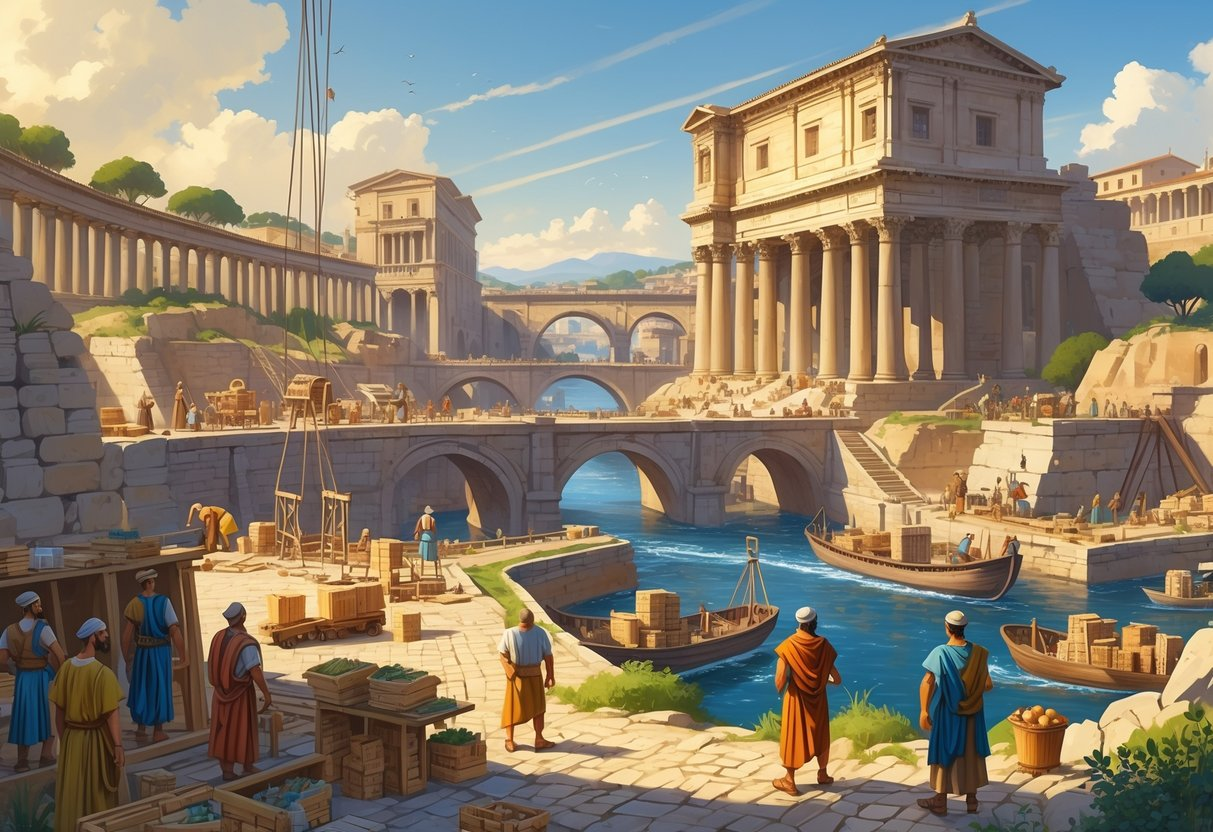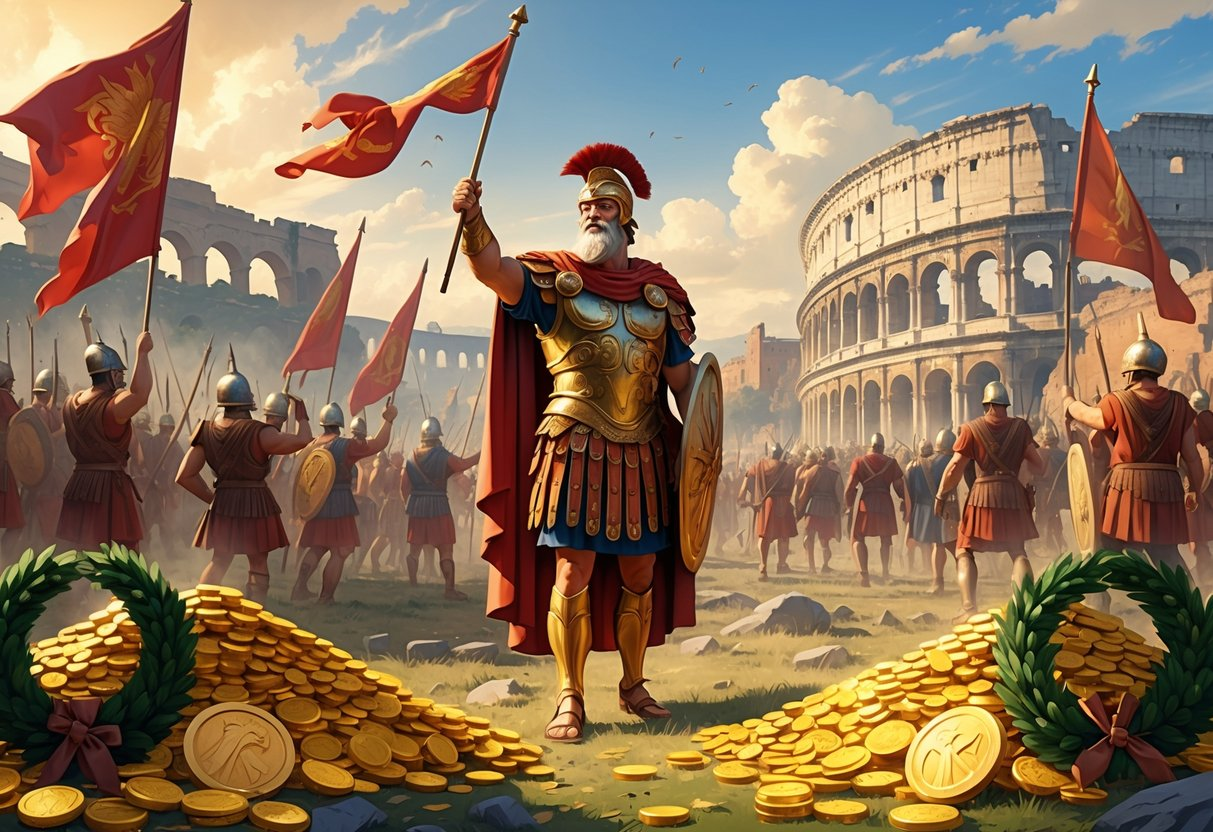The scale of ancient Roman infrastructure did more than just shape the empire’s landscape—it defined its economy. Roads, aqueducts, and big buildings connected far-off provinces, made trade possible, and helped cities grow.

Studies like Assessing the economic impact of building projects in the Roman world and Building mid-republican Rome: labor, architecture, and the urban economy show how construction projects fueled jobs and new ideas. Every new road or public building was more than just an engineering win—it was an investment in economic stability and expansion.
The legacy of Roman engineering still pops up in how we plan modern infrastructure. From the toughness of ancient roads to the way cities are organized, Rome’s lessons stick with us today.
Roman Infrastructure and Economic Development

Roman infrastructure shaped how people traded, produced goods, and governed. Investments in roads, bridges, and ports made it easy for goods, people, and news to move across the empire, tying far-off regions into Rome’s economy.
The Role of Roman Roads in Economic Growth
The Roman road network was the backbone of the empire’s economy. Built to last and go straight from point A to B, these roads linked big cities, ports, and army bases.
Studies show that the Roman road network influenced modern infrastructure in Italy. Roads like the Via Appia helped move farm goods and raw materials, which cut transport costs and helped markets grow.
Provinces with more roads ended up with stronger trade centers and more people. Even today, areas near old Roman roads often have more businesses and bigger cities.
The long-term effects of the Roman road network can still be seen, connecting ancient investments to today’s economic activity.
Integration of Trade and Markets Across the Empire
Good infrastructure let the Romans tie together local economies into one big market. Roads, harbors, and bridges helped producers and buyers connect, no matter how far apart they were.
The relationship between infrastructure and economic growth shows that better connections meant more trade and less regional inequality.
Merchants could easily bring grain from Egypt, wine from Gaul, and textiles from Asia Minor to Rome. Standard weights, measures, and currency made trade easier.
Here’s a quick look at how infrastructure helped trade:
| Infrastructure Feature | Economic Effect |
|---|---|
| Roads and Bridges | Lower transport costs |
| Ports and Harbors | Expanded maritime trade |
| Standardized Systems | Easier market exchange |
These connections made everything more stable and let regions specialize, helping local economies grow as part of the empire.
Military Logistics and Administrative Control
Roman infrastructure wasn’t just for business—it was also about control. Roads built for the military ended up helping trade and communication, too.
The economic side of the transportation system shows how army roads turned into trade routes. Good roads let legions move fast, which kept provinces under control and cut down on rebellions.
This made things safer for private investment and farming. Officials also used these roads to collect taxes, send messages, and manage resources.
The mix of military and economic uses made infrastructure a tool for both power and prosperity.
Engineering Innovations and Construction Techniques

Roman engineers built a huge network of tough roads and bridges that kept trade, armies, and messages moving. Their building methods—like careful planning, layering materials, and skilled stonework—influenced how people built things for centuries.
Roman Road Construction Methods
Building a Roman road was a step-by-step process that focused on strength and drainage. Engineers used tools like the groma to map out straight lines. Workers dug trenches and filled them with layers.
A typical Roman road looked like this:
| Layer | Material | Purpose |
|---|---|---|
| Statumen | Large stones | Foundation |
| Rudus | Crushed stones and lime | Strength |
| Nucleus | Gravel or sand | Leveling |
| Summum dorsum | Stone paving blocks | Surface |
This design let heavy carts pass without wrecking the road. Projects described in Assessing the economic impact of building projects in the Roman world show how organized labor and supply chains made these massive builds possible.
Durability and Maintenance of Ancient Roads
Roman roads lasted for ages because of smart engineering and regular repairs. Builders used tightly fitted stones that stood up to erosion and let rainwater drain away.
Maintenance crews—sometimes local towns, sometimes the army—checked for damage and swapped out broken stones. This kept roads ready for business and the military.
Some Roman roads are still around today, showing just how tough their construction was. Innovations like early concrete, described in Concrete vaulted construction in Imperial Rome: innovations in context, made roads and buildings even stronger.
Roman Bridges and Architectural Marvels
Roman bridges were both strong and stylish, thanks to arches and concrete. Builders used opus caementicium (Roman concrete) and stone blocks to spread out the weight.
The Pont du Gard in southern France is a great example—it worked as both an aqueduct and a bridge, showing off Roman engineering skills.
Bridges often had several spans with piers sunk into riverbeds. Designs changed depending on the landscape, but the basics of balance and compression were always there.
Key Routes: The Via Appia and Beyond
The Via Appia, called the “Queen of Roads,” connected Rome to southern Italy. Its straight path and tough basalt paving made it a model for future projects.
Other major roads like the Via Flaminia and Via Aurelia stretched the network across Italy and into the provinces. These routes kept trade, taxes, and troops moving, tying distant places to the capital.
Projects covered in From Ashlar to Brick: Anchoring and Innovation in Roman Building Practice show how new materials and methods helped engineers adapt to different environments while keeping up quality.
Legacy and Influence on Modern Infrastructure
Roman engineering left a huge mark on modern infrastructure in Europe and beyond. Old road systems, city layouts, and water works shaped how people settled, traded, and traveled—and those patterns still influence us today.
Persistence of Roman Road Networks in Modern Europe
The Roman road network set up a durable system for moving around the continent. A lot of today’s highways and railways in Italy and Western Europe still follow the old Roman routes.
Research on modern infrastructure in Italy shows that major transport lines match up with the old consular roads. These routes tied together cities and ports, helping trade and administration during the Empire and later guiding medieval and industrial growth.
The network’s staying power comes from smart design. Roman engineers made roads straight, paved, and well-drained, with standard widths. Their roads linked distant provinces to Rome, building a unity that lasted long after the Empire was gone.
| Feature | Roman Design | Modern Equivalent |
|---|---|---|
| Alignment | Direct, strategic routes | National highways |
| Materials | Stone paving and mortar | Asphalt and concrete |
| Function | Trade, military, governance | Commerce and commuting |
Impact on Urban Planning and Transportation
Roman city planning influenced how European cities grew. Many towns formed around Roman forums, walls, and aqueducts, shaping later street layouts and infrastructure.
In early modern Rome, hydraulic infrastructure helped cities grow and stay clean. Old aqueducts were reused for new fountains and water systems, showing how Roman engineering kept on working.
Modern city planning still echoes these old patterns. Cities like London, Paris, and Cologne have layouts that trace back to Roman days. The fact that these structures still shape cities today shows just how lasting Roman infrastructure really is.
Comparative Developments: North Africa and the Middle East
Roman infrastructure reached way beyond Europe. In North Africa and the Middle East, roads, bridges, and aqueducts connected places like Carthage, Leptis Magna, and Palmyra.
People in these regions tweaked Roman engineering to fit their own needs. Stone-paved roads linked farms to coastal ports, making it easier to trade across dry areas.
A lot of these routes later became the base for colonial and modern transport systems. Even when political control shifted, the Roman focus on staying connected stuck around.
Roman ideas about road alignment and city planning ended up influencing both Islamic and European infrastructure during medieval times. Ancient systems kept shaping development across continents.



Leave a Reply